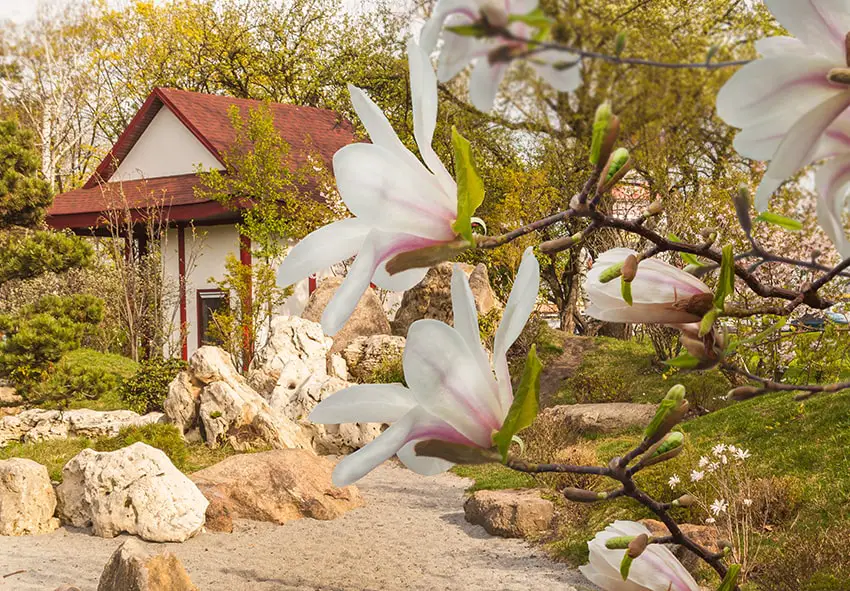Oriental gardens description
Gardens in the oriental style (Japanese, Chinese, Korean) are among the most beautiful in the world, due to the fact that they have harmoniously combined elements necessary to create an atmosphere of absolute peace, balance and incredible beauty in different seasons. The philosophical and religious tradition of the East developed the contemplation of blossoming, the so-called hanami (contemplation of sakura or magnolia blossoms) and geta (hunting for the beauty of autumn maples), which means admiring every moment of being, seeing the beauty of every season.

To stylize an oriental garden, traditional plants for the East are planted: Japanese maple, sakura or magnolia, adding pebbles, bamboo sticks, a bowl or an oriental lantern to the composition.

Sakura
The most symbolic tree of the oriental garden is the sakura, without the flowering of which it is impossible to imagine the Japanese spring. Sakura feels good in Ukraine, as evidenced by the Kyoto Park in Kyiv with the longest cherry blossom alley in the world or the longest cherry blossom alley in Europe in Uzhgorod, cherry blossom alley in Mukachevo, etc.

The classification of trees related to sakura is conditional, they include not only cherries, but also plums. In nursery catalogs, sakura varieties and decorative cherries are assigned to zone 6, that is, in the territory from the center of Ukraine and north of the cultivation is associated with additional care, especially in the period of preparation for winter, shelter in winter, sensitivity to temperature changes during early thaws and return frosts .

The place for landing should be sunny, protected from cold winds. Sakura likes well-drained soil, light loam, with a neutral reaction. It is better to plant on a south-west slope. On the south side, the tree will suffer from a lack of moisture, and in winter from a temperature drop and possible sunburn. Sakura will not develop in the lowlands. In the first years, the seedling is sensitive to drought, so it needs mandatory watering.
Caring for them is similar to caring for other cherries. Only sanitary pruning is carried out in young trees.
Magnolia

Magnolia symbolizes generosity and nobility of soul in an oriental garden. It was also grown in Chinese monastery gardens. In Ukraine, magnolia grows in the botanical gardens of Kyiv (named after Hryshko and Fomin), the botanical garden of Kharkiv National University named after V.N. Karazin, in the garden of Lviv National University named after Ivan Franko, Odesa Botanical Garden named after I.I. Mechnikov, etc.

Although magnolia is heat-loving, it feels good not only in the south of Ukraine, because one of the biological features of this plant is its high adaptability to changes in environmental conditions. The most winter-hardy are Kobus and Lebner magnolias.

Garden forms of Sulang, Wilson, and Ash are relatively winter-hardy. In very severe frosts, they freeze only some flower buds, which does not harm the tree or bush. The winter hardiness of magnolias increases with age, and they no longer need shelter for the winter. The soil for magnolia should be fertile, rich in organic matter, with good drainage, and sufficiently moist. Different types of magnolias require different soil reactions from neutral to slightly acidic. For the winter, it is recommended to insulate the trunk circles with fallen leaves, peat, compost and other mulching materials. Only sanitary pruning is carried out, cutting out dried branches.
Japanese maple

The maple tree is especially revered in Japan as a symbol of learning, life wisdom, greatness, so it is necessarily planted in temple and monastery gardens. These trees look great in rockeries, near water, and in mixed borders. Due to their compact size, Japanese maples make excellent container plants that can be placed on the patio or in front of the main entrance of the house. Topiary]and bonsai are formed from Japanese maples. In Japan, maple trees in tubs are installed at eye level so that everyone can admire the shape of the trunk, the elegance of the crown and the brightness of the leaves of these magical plants.

It is very important to choose the right place for the maple on the plot: it needs a well-lit, but protected from midday rays area (perhaps in the shade of a taller tree), where there would be enough space for a wide umbrella crown, it is also important that at any time year you could admire the changing appearance of this beautiful tree. It should also be taken into account that maple does not like strong winds or cold drafts. The soil for maples should be fertile, rich in organic matter, with good drainage, and sufficiently moist. Japanese maple is a heat-loving plant, winter time is quite stressful for it. For successful wintering, it is recommended: in late autumn, spread a layer of mulch 10-13 cm thick around the root system; insulate the trunk with covering material. If you follow all the rules, your plant will overwinter quite successfully.
Other plants for the oriental garden

Decorative grasses and ground cover plants, mosses will fit in harmoniously among cherry blossoms, magnolias or maples. Rhododendrons, azaleas, Japanese irises, Siberian irises, ferns, hosta are also suitable. And chrysanthemums, peonies and daylilies, but not in large numbers. A gazebo styled as a tea house will create an atmosphere of an oriental garden.
Magnolias, cherry blossoms and Japanese maples, as well as other seedlings of decorative trees of the best quality, can be purchased in the Florium online store.
Sincerely, experienced gardener, Olesya.
Read also Eucomis.
Published: 30.01.2020

